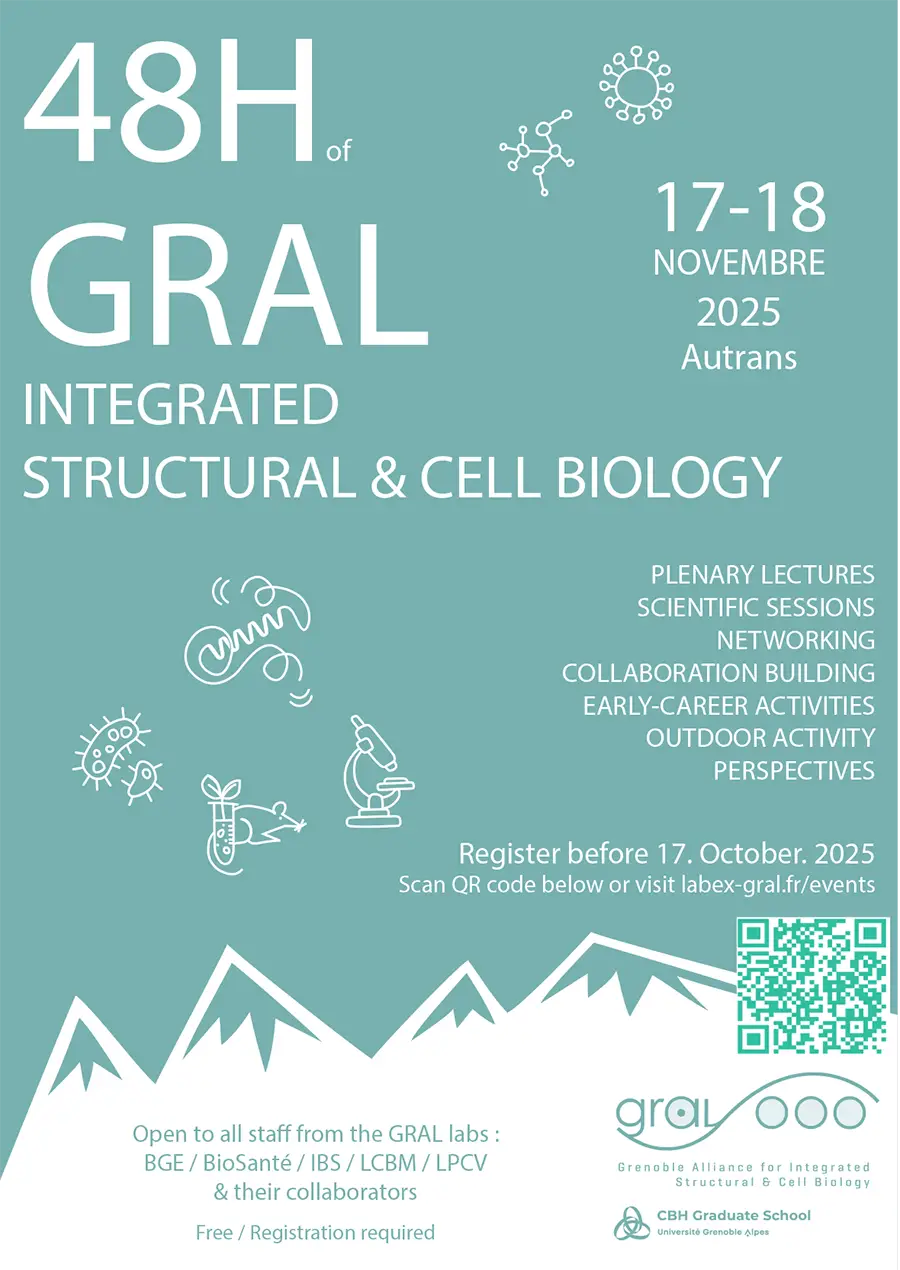The 48H of GRAL seminar will take place on 17-18 November 2025 in L’Escandille, Autrans.
The “48H of GRAL” is an excellent opportunity to strengthen interactions within the GRAL community, and included plenary lectures, poster sessions, and discussions. Approximately 150 participants from the GRAL labs (BioSanté, BGE, IBS, LCBM, and LPCV) as well as close collaborators in Grenoble (DPM, EMBL, ESRF, GIN, IAB, LBFA, LIPHy, SyMMES, TIMC, …) are expected.
Link to register to the event >
https://ec.europa.eu/eusurvey/runner/GRAL-48H-2025
Programme of the 48H of GRAL:
Monday, November 17th 2025
8:00 – 8:30 Meeting in Presqu’île
8:30 Bus departure
9:30 Arrival in Autrans, check-in & coffee
10:15 – 10:30 Opening by GRAL directors
SESSION 1. Infection Biology
10:30 – 11:15 KEYNOTE Petr Chlanda, Department of Infectious Diseases, Virology, Heidelberg University.
Morphology-Dependent Spread and vRNP Clustering in Influenza A Virus
11:15 – 11:35 Christopher swale, IBS. Targeting RNA Processing Pathways in Apicomplexa.
11:35 – 11:55 Cécile Morlot, IBS. Building the spore’s armor: a cryo-FIB-tomography exploration of macromolecular assemblies.
11:55 – 12:15 Borys Pedenko, Inst. Pasteur. Destabilising properties of the novel broadly neutralising antibody targeting HIV-1.
12:15 – 13:45 Lunch
13:45 – 16:30 Outdoor activities to choose between Hiking, Biathlon, Treetop Climbing (Accrobranches), Relaxing at Escandille.
SESSION 2. AI & Technical Session
16:30 – 17:15 KEYNOTE Joana Pereira, Katholieke Universiteit Leuven. Charting the Unknown: AI-Powered Classification and Discovery Across the Protein Universe
17:15 – 17:35 Elise Delaforge, IBS. Combining NMR and X-ray crystallography to reveal novel kinase binding motifs in long disordered scaffold proteins.
17:35 – 17:55 Sergei Grudinin, MJK. Can we learn protein motions?
17:55 – 18:15 Eymeline Pageot, IBS. Integrative structural biology of cell extracts: a Blob case study.
18:15-18:30 – Darren Hart – ISBG Platforms presentation.
18:30 – 20:00 PhD projects and Platforms poster session.
20:00 Dinner
Tuesday, November 18th 2025
SESSION 3. Genome Biology & Cellular Function and Dysfunction
8:45 – 9:30 KEYNOTE Christian Fankhauser, EPL Lausanne.
Regulation of growth by PIF transcriptional factors in response to changes in the environment.
9:30 – 9:50 Delphine Pflieger, BGE. Investigation of the cross-talk between metabolism and histone modifications through multi-omics analysis.
9:50 – 10:10 Moïra Arnoux- Courseaux, LPCV. Beyond structure, insights into the evolution of land plants from the LFY-UFO partnership.
10:10 – 10:30 Nadia Cherradi, Biosanté. Wnt/β-Catenin Pathway-Driven microRNA Dysregulation in Adrenocortical Carcinoma – Diagnostic and Therapeutic Relevance.
10:30 – 11:00 Coffee break and Group Picture in front of l’Escandille.
11:00 – 11:20 Stéphanie Hutin, LPCV. Disorder with purpose: ELF3 Phase Separation Tunes Plant Temperature Response.
11:20 – 11:40 Etienne Dubiez, IBS. Structural insights into nascent RNA fate determination
11:40 – 12:00 Carmen Coirry, BGE. The deubiquitinase USP36 functions through catalytic-dependent and catalytic-independent mechanisms in Drosophila.
SESSION 4. Cellular Organization
13:40 – 14:00 Isabelle Arnal, GIN. Exploring the inner life of microtubules: from structure to function.
14:00 – 14:20 Aurélien Déniaud, LCBM. Disrupting copper distribution in cancer cells: from homeostatic mechanisms to therapeutic innovation.
14:20 – 14:40 Monika Dolega, IAB. Uncovering nucleolar mechano-adaptation.
14:40 – 15:00 Alessio D’Acapito, IBS. Cryo-Electron tomography study of the bacterial cell wall perforation by bacteriophage T5.
15:00 – 15: 20 Closing words &Announcement of student poster awards
16:00 Departure
17:00 – 17:30 Arrival in Grenoble
ABSTRACTS
Petr Chlanda, Heidelberg University, Department of Infectious Diseases – Virology
Morphology-Dependent Spread and vRNP Clustering in Influenza A Virus
Influenza A viruses (IAV) form pleomorphic virions, ranging from spherical to filamentous shapes. These morphologies influence viral entry, spread, and immune evasion. Laboratory-adapted strains are mostly spherical, but the determinants of morphology in physiological conditions remain unclear. To investigate this, we generated fluorescent reporter viruses with identical glycoproteins but distinct morphologies and applied correlative light and scanning electron microscopy. Filamentous IAV spread more slowly across cell lines, consistent with delayed entry observed by in-cell cryo-ET, explaining the predominance of spherical forms in labs. Spread was not affected by cellular junction integrity, neuraminidase activity, or mucin, but filamentous virions had an advantage under hemagglutinin-targeted neutralizing antibodies.
IAV is a segmented negative-sense RNA virus, with eight genomic segments assembled into helical vRNPs in the nucleus. vRNPs traffic via Rab11 to the plasma membrane, where assembly is orchestrated by M1, HA, and NA. Using in situ cryo-electron tomography, we found that HA-containing membranes cluster vRNPs, reducing nearest-neighbour distances. M1 forms multilayered helical complexes in nucleus and cytosol, distinct from budding virions, and M1 layer formation precedes membrane attachment and vRNP bundle formation. Overall, vRNP clustering occurs on HA membranes, and the canonical 7+1 vRNP arrangement is established during virus budding.
Christian Fankhauser, EPFL Lausanne
Regulation of growth by PIF transcriptional factors in response to changes in the environment.
In Arabidopsis, responses to light and temperature are heavily regulated at the transcriptional level. Vegetational shade or increased ambient temperature can limit photosynthesis and are rapidly perceived by phytochromes (phy) photoreceptors by promoting their return to the inactive state. This releases phy-mediated repression of a group of bHLH transcription known as PHYTOCHROME INTERACTING FACTORs (PIFs). Active PIFs rapidly reprogram gene expression leading to growth responses favouring access to unfiltered sunlight such as elongation of hypocotyls in seedlings. In Arabidopsis two members of the PIF family are particularly important for responses to shade and elevated temperature: PIF4 and PIF7. In this presentation I will present data on the chromatin landscape of PIF target genes. Our results suggest that in seedlings a state of open chromatin conformation allows PIFs to easily access and recognize their binding motifs, rapidly initiating gene expression triggered by shade. This transcriptional response primarily depends on a transient increase in PIF stability and gene occupancy, accompanied by changes in chromatin accessibility in a minority of genes. I will also present work on the mechanisms underlying the function and regulation of PIFs by light and/or temperature. Indeed, while active phytochromes, in particular phyB, inhibits PIFs, the underlying mechanisms are still poorly understood and are at least in part different for PIF4 and PIF7.
Joana Pereira, VIB Center for AI and Computational Biology, Leuven, Belgium – KU Leuven
Charting the Unknown: AI-Powered Classification and Discovery Across the Protein Universe
The protein universe remains only partly charted, with countless families and functions yet to be uncovered. By harnessing large-scale datasets of protein sequences and structures, we recently introduced an unsupervised representation of this space that identifies functionally meaningful clusters across millions of proteins. This data-driven framework enables systematic prioritization and characterization of uncharacterized families, generating candidates for experimental validation. Through this approach, we revealed new biology at scale, including unrecognized prokaryotic defense systems and a previously undescribed repetitive protein fold, the β-flower.
Although the biological role of proteins adopting the β-flower fold remains unknown, we demonstrate that these sequences are remarkably diverse at both sequence and structural levels. They are predominantly encoded in metagenomic datasets, with expression patterns that are not yet understood. Importantly, experimentally determined structures confirm the existence of the β-flower fold, offering opportunities for engineering repetitive, soluble β-barrel–like architectures. Together, these results highlight the transformative potential of AI-guided discovery and establish the foundation for a dynamic, ever-expanding atlas of the protein universe, accelerating efforts to decode molecular functions, trace evolutionary trajectories, and inspire protein design across the tree of life.

